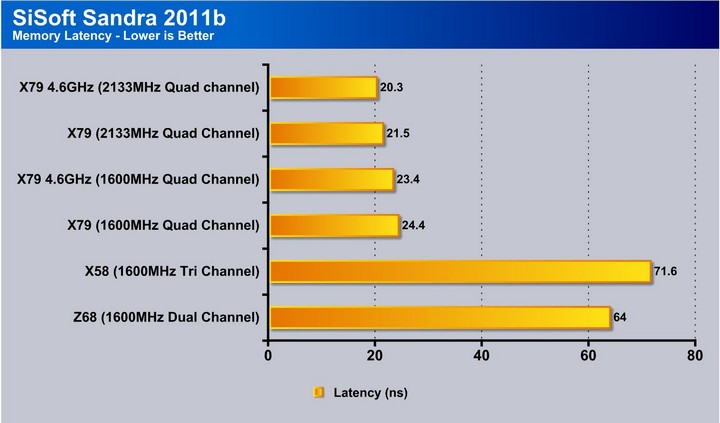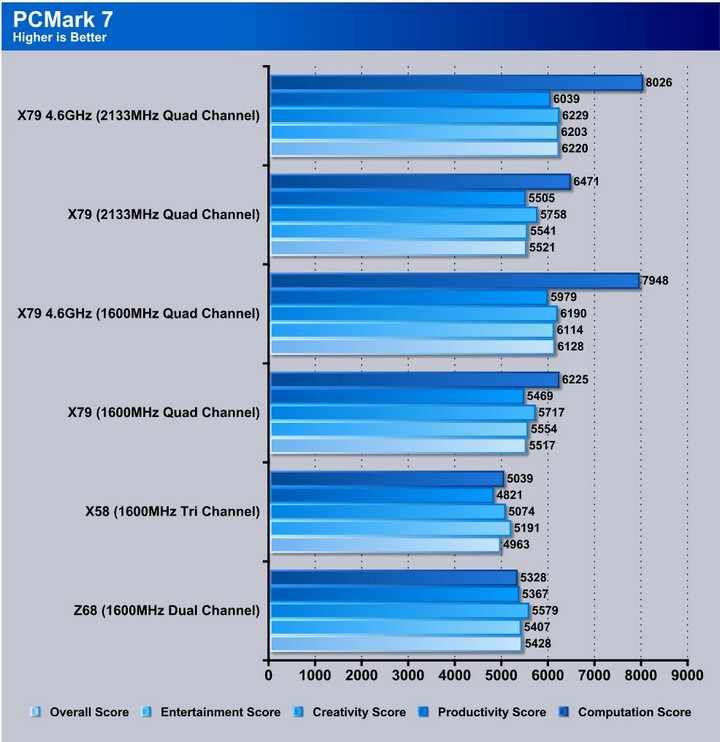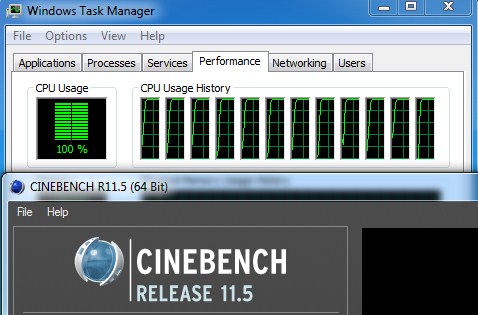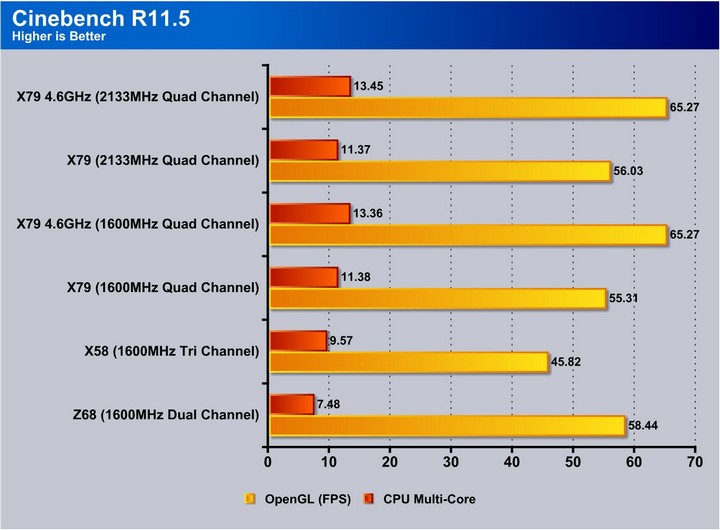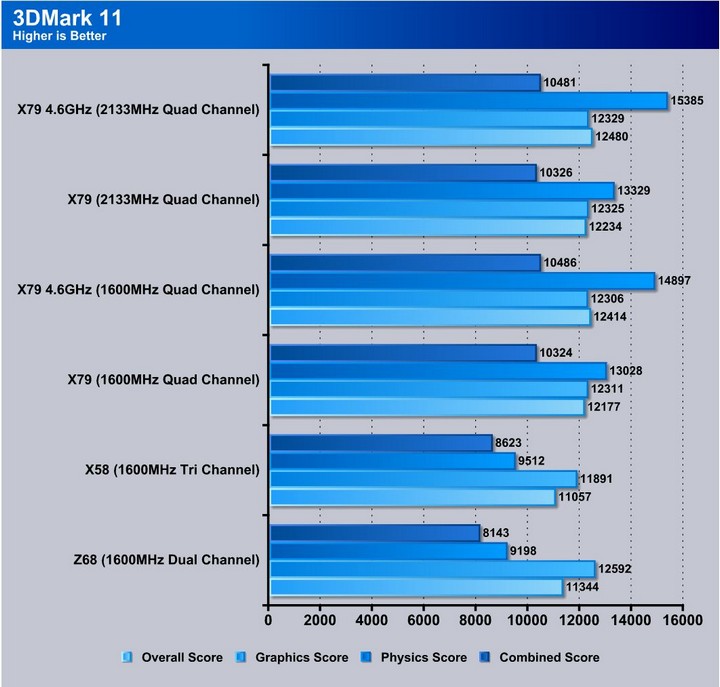Here is one of G.Skill’s newest offerings for the X79 chipset. Let’s see how this quad-channel monster performs.
Introduction – G.skill F3-17000CL9Q-16gbZH
Today we have in our hands one of G.SKILL’s newest lines in the Ripjaws series: the Ripjaws Z which are designed for the quad channel memory controller in the newly released Intel X79 based boards. This kit is not their top model in terms of performance, but boasting a frequency of 2133 with a CAS latency of 9 is in no terms bad either. These are more of the upper high end for a 16GB kit, as G.SKILL does offer some models with slightly better timings or higher speeds, but those also can be much more expensive.
In this review we will look at the specifics of this memory kit and test how it performs. This kit is at the middle of the high end segment due to its high speed profile, and to our surprise, it is on the market presently for $154.99. This is quite surprising due to the fact that it is a 16GB kit and at such a high speed, so let’s take a look at the kit and what merits it carries that would make us purchase it.
Pictures & Impressions
The packaging is the standard blister pack style enclosure, but since this kit has 4 DIMMs, it has modules on both sides. Once removed, we can see the middle paper for the enclosure holds some info as to the Ripjaws Z series modules and their compatibility with the X79 chipset boards. Also note that the G.SKILL modules carry a lifetime warranty so if they ever fail in the time we own them, we can just send them in and get a replacement.
Here we see a few detailed images of the modules, kind of an in depth look at the specifics of the modules such as the specific details and what makes them special. First we look at the modules’ label and the information it holds. On the label we see the specs such as the rated speed.
| M/B Chipset |
Intel X79 |
| CAS Latency | 9-11-10-28-2N |
| Capacity |
16GB (4GB x4) |
| Speed | DDR3-2133 (PC3 17000) |
| Test Voltage | 1.65 Volts |
| Height | 40 mm / 1.58 inch |
| Registered/Unbuffered | Unbuffered |
| Error Checking | Non-ECC |
| Type | 240-pin DIMM |
| Warranty | Lifetime |
| Features | Intel XMP (Extreme Memory Profile) Ready |
These modules are listed as rated for PC17000 or 2133MHz, which is very high by any standard, and though there are faster, we would question the real world benefits from going even higher than this. That being said there is a reason higher speed modules are made, and that is because there is a market to have the highest amount of bandwidth available. Rendering jobs amongst many other memory heavy apps will definitely see a benefit from any increase in bandwidth, but what we look at today will be if the increase is worth the investment.
The X79 chipset as covered before supports quad channel memory, which in itself is the recipe for a insane amount of bandwidth. The 1155 Sandy Bridge architecture shows amazing memory bandwidth results, so we definitely want to see what Sandy Bridge-E has in store with twice the memory channels.
Testing & Methodology
Memory Testing can be a little tough to quantify the benefits so we have the 2133 MHz kit here and we plan on some testing variations to give the best idea of scenarios where a gain will be seen with the higher speed and bandwidth offered by the 2133MHz kit.
We will be testing both 1600MHz (9-9-9-24) and of course the XMP 2133MHz profile that comes pre programmed to these modules. Also we will be overclocking the CPU as well to show the difference and how well it will improve the usage of the extra bandwidth.
Test Rig
| Test Rig | |
| Case | Thermaltake Level 10 GT |
| CPU |
Intel Core i7-3960X |
| Motherboard | ASUS Rampage IV Extreme |
| RAM | 16GB Gskill F3-17000CL9Q-16GBZH (4x4GB) |
| CPU Cooler |
Swiftech H20-220 Edge |
| Hard Drive | Western Digital Velociraptor 300GB |
| SSD |
Intel 510 series SATA III 120GB |
| Optical | ASUS BD-ROM |
| GPU |
2x GTX 580 SLI |
| Case Fans |
Front (intake): 200 x 200 x 20 mm ColorShift Fan x 1 (600~800RPM, 13~15dBA) Rear (exhaust): 140 x 140 x 25 mm Turbo Fan (1000PRM, 16 dBA) Top (exhaust): 2x120mm fans mounted to Radiator for Swiftech H20-220 Edge kit Side (intake): 200 x 200 x 30 ColorShift Fan (600~800RPM), 13~15dBA) |
| Additional Cards |
N/A |
| PSU |
Thermaltake Toughpower Grand 1200W |
| Mouse | Tt eSPORTS Black gaming mouse |
| Keyboard | Tt eSPORTS Meka G1 mechanical gaming keyboard |
Test Suite
We will use the following applications to test the performance of the memory. Benchmarks
| Benchmarks |
|---|
| Sandra 2011 |
| PCMark 7 |
| 3DMark 11 |
| Cinebench R11.5 |
SiSoft sandra 2011
“SiSoftware Sandra (the System Analyzer, Diagnostic and Reporting Assistant) is an information & diagnostic utility. It should provide most of the information (including undocumented) you need to know about your hardware, software and other devices whether hardware or software. It works along the lines of other Windows utilities, however it tries to go beyond them and show you more of what’s really going on. Giving the user the ability to draw comparisons at both a high and low-level. You can get information about the CPU, chipset, video adapter, ports, printers, sound card, memory, network, Windows internals, AGP, PCI, PCI-X, PCIe (PCI Express), database, USB, USB2, 1394/Firewire, etc.”
Here have the results of just pure raw memory bandwidth and we can clearly see that the quad channel setup at default punches up some very impressive numbers, clearly jumping far ahead of both the Z68 dual channel results and the previous generation X58 triple channel results as well. We are very surprised to see an almost 100% increase over the Z68 which means no matter how demanding the application, it will be tough to max out the quad channel setup. Take note that when overclocking the processor the numbers improved even further, which goes to show that at default, the CPU (which is a monster to begin with) is actually a bottleneck for the memory so some overclocking would not only drastically improve the memory results for memory bound apps but likely speed up processing tasks as well.
The 3960X IMC does not fail to impress here as the quad channel latency is extremely low in comparison to even the little Sandy Bridge the Z68. This was quite surprising as we were thoroughly stunned as to the memory performance from the 1155 platform at launch and words cannot describe how results like this make us feel as 1600MHz CAS 9 results in sub-25 ns latencies and when brought up to speed it drops almost to sub 20ns range.
PCMARK 7
PCMark 7 is the latest system benchmark tool from Futuremark. The benchmark consists of tests such as application launches, file searches, web browsing, video playback, photo editing, and gaming.
With the results shown here the overall system work output can increase quite dramatically as the speed is increased in sync with the increase in output.
Wprime
Wprime is a processor heavy multithreaded benchmark at which it crunches numbers of a specific data set and gives the end user an output time which can then be used as a guage to compare system performance.
Here we see that this multi threaded benchmark has an overall increase in efficiency along with a definitely improvement when the CPU is overclocked in tandem.
Superpi
SuperPi is a single threaded benchmark which measures efficiency and is heavily influenced by architectural changes as much as it is by clockspeeds.
SuperPi is a much older benchmark, but is still used today as it is a good measure of efficiency improvements in a single threaded application. As shown here as the clock speed increases just on the memory alone the scores get ever so better and once again once the CPU is overclocked as well it drops very quickly in processing time.
CINEBENCH R11.5
“CINEBENCH is a real-world test suite that assesses your computer’s performance capabilities. MAXON CINEBENCH is based on MAXON’s award-winning animation software, CINEMA 4D, which is used extensively by studios and production houses worldwide for 3D content creation. MAXON software has been used in blockbuster movies such as Spider-Man, Star Wars, The Chronicles of Narnia and many more. MAXON CINEBENCH runs several tests on your computer to measure the performance of the main processor and the graphics card under real world circumstances. The benchmark application makes use of up to 16 CPUs or CPU cores and is available for Windows (32-bit and 64-Bit) and Macintosh (PPC and Intel-based). The resulting values among different operating systems are 100% comparable and therefore very useful with regard to purchasing decision-making. It can also be used as a marketing tool for hardware vendors or simply to compare hardware among colleagues or friends.”
Cinebench 11.5 has not only a multithreaded CPU performance benchmark but an OpenGL test, and both results increased in scale with the memory frequency. This speaks very well to the fact that the memory is part of the overall picture with the system, and when one is increased, sometimes another component must be brought up to speed to ensure that one is not slowing down another.
3DMARK 11
3DMark 11 is the newest in futuremark’s suite of benchmarking utilities. It’s a fully capable DirectX11 benchmark which also stresses and analyzes the system performance as a whole to simulate a heavy rendering environment such as a high end game or other app the end user may run. This benchmark was run with Performance settings 5 times and all runs were averaged for the result below.
3DMark 11 is a good 3D benchmark that allows us to see the overall system performance increase, especially to interpret gaming increases that we could expect with the improvements. As we see, this memory didn’t increase performance by large margins, but there would be some FPS increase in games.
CONCLUSION
The Ripjaws Z modules are part of an overall package which makes for the ultimate high performance system. No matter if gaming or photo/video editing the new Ripjaws Z kit has the ability to increase performance and get more work done faster. The price point is spot on for a high capacity 16GB kit with such high performance.
The build quality of the modules is second to none as the heatspreaders alone not only look cool but they keep the modules cool as well and they are very thick and sturdy. These modules are just flat out thick chunks of metal.
Anyone building a LGA2011 system would be hard pressed to find a reason not to consider the Ripjaws Z series, now of course the exact module would be subjective to the user and what they will be using them for.
| OUR VERDICT: 16GB G.Skill F3-17000CL9Q-16GBZH | ||||||||||||||||||
|
||||||||||||||||||
| Summary: The 16GB G.Skill Ripjaws Z Performs as well as–if not better than–it looks and for a great price. For its performance and value it earns the Bjorn3D Golden Bear Award. |
 Bjorn3D.com Bjorn3d.com – Satisfying Your Daily Tech Cravings Since 1996
Bjorn3D.com Bjorn3d.com – Satisfying Your Daily Tech Cravings Since 1996










